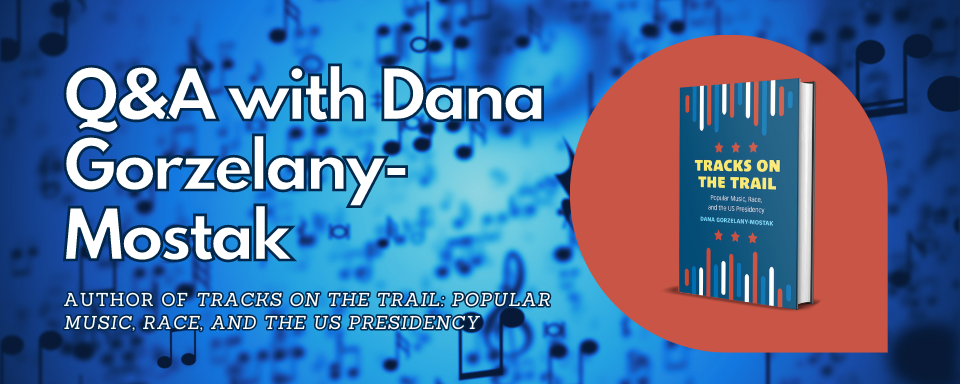Q&A with Dana Gorzelany-Mostak

This guest author post is a Q&A with Dana Gorzelany-Mostak, author of Tracks on the Trail: Popular Music, Race, and the US Presidency, from the University of Michigan Press. The book is available in hardcover, paperback, and open access.
How did you first get interested in writing a book about the use of popular music in US presidential campaigns?
As a PhD student, I wrote a paper on the Vote for Change Tour, a series of concerts that encouraged voters to head to the polls in 2004. This sparked my interest in music and US presidential campaigns. In my research, I noted that journalists focused on lyrics when discussing candidates’ use of music on the trail. Lyrics are an important vehicle for the communication of meaning, but I was interested in investigating other ways music might convey ideas within the context of a campaign. A song (or a playlist) can assert a political message, an ideological orientation, a worldview, or a set of values, and this affective and persuasive power resides in its sounds, not just the semantic content of its lyrics (Middleton 2000). Tracks on the Trail: Popular Music, Race, and the US Presidency analyzes the ways candidates engage with popular music as a part of their campaign strategy, and the ways voters use music to engage in the deliberative process.
What are some of the most memorable songs associated with a political campaign?
Every time I tell someone over the age of fifty about my research interests, they almost always cite the same example: “Don’t Stop,” the 1977 Fleetwood Mac song that Bill Clinton used during his 1992 campaign.
Why does this candidate-music pairing still resonate with folks over thirty years later?
The song effectively encapsulated Clinton’s biography, personality, and platform. His nostalgic rally playlist, which included classics by artists such as the Beatles, Elvis, and Mary Wells, and of course his saxophone wielding on The Arsenio Hall Show, affirmed his pop-culture savvy and hip persona as well as allowed him to establish common ground with his fellow baby boomers.
In the decades since, journalists, pundits, and online commenters alike have often referred to Bill Clinton when discussing music on the trail. This is one of the reasons why I chose to frame my book around Clinton’s 1992 music strategy.
Why do politicians sometimes use music by artists who are politically opposed to them? How often do musicians complain when that happens?
Most candidates discontinue using a song if the artist protests, as no one wants bad publicity. Former president (and now presidential candidate) Donald Trump is the outlier here in that he frequently uses the music of artists whose political views are antithetical to his own (and who have protested his use of their music). But this plays into the presidential brand he has worked to cultivate since 2015. To his supporters, he is a renegade and a rulebreaker—a candidate who is not afraid to assert himself and disrupt the status quo. The message here is not so much from the music itself, but from the way the music is used. I would argue that the noisy chorus of objections from artists is the true soundtrack of the Trump campaigns.
Readers may not know that you have also worked on the research project “Trax on the Trail” - can you tell us a little bit about the project and where people can go to learn more?
Launched in 2015, Trax on the Trail is a website and research project that tracks and catalogs the soundscapes of contemporary US presidential campaigns. Along with other scholars in the US and Canada, I created the Trax on the Trail website with the goal of promoting a more critical evaluation of how music and sound shape the public’s perceptions of presidential candidates. To that end, Trax on the Trail provides accessible content on the topic of music and elections, including essays, podcasts, digital lectures, and educational materials. The cornerstone of the website is a database where our team tracks music heard on the trail. With over 8000 entries compiled since 2015, our database represents the first attempt to document, analyze, and catalog campaign soundscapes.
The Trax on the Trail project has been cited by various media outlets, including Politico, Newsweek, the BBC, The Guardian, Slate, The Boston Herald, Pacific Standard, and Inverse, and our work has been published in the Journal of Popular Music Studies, American Music, and Music & Politics.
Tracks on the Trail: Popular Music, Race, and the US Presidency is the outgrowth of this website and research project.
You can hear diverse perspectives about music on the trail at www.traxonthetrail.com.
What do you think would be an ideal campaign song?
The ideal campaign song features the perfect marriage of inspirational lyrics, an energetic beat, and an infectious hook. The ideal campaign song (or playlist) should not only authentically represent the candidates’ history, tastes, values, and vision, but also speak to the tastes and interests of the candidate’s core constituency. Barack Obama used Stevie Wonder’s “Signed, Sealed, Delivered I’m Yours” in 2008, and that is about as perfect as it gets. You can read about it in chapter two of the book!



